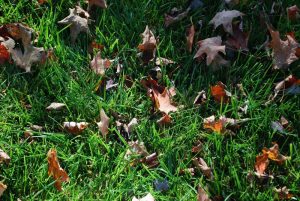 It’s finally here! Leaves are changing color, temperatures are dropping, there’s pumpkin-spice flavoring in everything, and stores are putting out their Christmas displays! It must be fall! But what fall landscape tips should you follow to get ready?
It’s finally here! Leaves are changing color, temperatures are dropping, there’s pumpkin-spice flavoring in everything, and stores are putting out their Christmas displays! It must be fall! But what fall landscape tips should you follow to get ready?
But what do you need to do, as a homeowner, to prepare your property for the coming winter? When is the right time to do it? Where do you start? Here’s the list of the top 5 things you should do for your landscape maintenance to prepare for winter:
Five Fall Maintenance Tips
1. Shrub trimming and perennial/ornamental grass cutbacks
Many of your landscape plants will benefit from taking the time to make sure they’re trimmed properly before winter. All of your perennials and tall ornamental grasses (like Karl Foerster grass) can be cut back pretty dramatically. Smaller ornamental grasses and perennials (like dwarf fountain grass or liriope) can be cut back this time of year. This healthy pruning, done properly, allows these landscape plants to retain their shape when they push new growth the following spring.
NOTE: There are certain plants that should NOT be cut back in the fall. Specifically, shrubs that bloom in spring, such as lilac, forsythia, azaleas, rhododendrons, and some viburnum. These plants should be trimmed immediately after bloom (think early June here in Central PA), so their flowers aren’t accidentally pruned off.
2. Winter Protects
Winter Protection treatments should be done after your shrub trimming in the fall. These are also called “anti-desiccant” sprays. What happens to many landscape plants in the winter is this; they lose moisture more quickly than they can take in new moisture from the root system. This process is called “transpiration”. When this happens, much of the leaf tissue of your landscape plants is irreparably damaged. Over the course of several winters, it can affect plant healthy by causing the loss of leaf tissue that is vital for photosynthesis.
Winter Protection treatments are a series of sprays done for your landscape plants to protect them from transpiration damage. This is why they’re called “Winter Protects;” it’s easier to remember than “transpiration sprays.” Generally, three are recommended through late fall and early winter for best coverage. The number of winter protective sprays done on your landscape will be dependent on the weather. If temperatures in your area start to freeze earlier than normal, you may only get one or two sprays completed. This is NOT a fool-proof way to prevent winter damage. But, for lots of landscape plants (azaleas, boxwoods, holly, rhododendrons, laurels, arborvitae, juniper, cedar and pine, to name a few), a winter protect can improve their long-term health.
You might also want to consider a physical barrier in some areas (burlap barrier as an example), like those particularly prone to gusty or consistent winds, to prevent these winds from causing additional stress and winter damage.
3. Clean Up Leaves
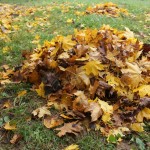 Recognizing that this one seems really obvious, you’d be surprised at the number of clients who don’t realize the impact that this can have on the health of your landscape. There’s even a whole argument from natural gardeners who will tell you that leaf litter is valuable compost material, and to “leave it” (see what we did there?) right where it lays.
Recognizing that this one seems really obvious, you’d be surprised at the number of clients who don’t realize the impact that this can have on the health of your landscape. There’s even a whole argument from natural gardeners who will tell you that leaf litter is valuable compost material, and to “leave it” (see what we did there?) right where it lays.
From the standpoint of a professional landscaping company who treats many landscape plants for diseases throughout the year, we’d disagree at least in part. Leaves make a great addition to a compost pile somewhere away from your beds. However, when piled too high in your landscape beds, leaf litter can simply foster a whole host of disease issues. In winter months, when sunlight, airflow, and regular moisture are lower than spring and fall, your plants are already under stress. Why increase the risk of stress by adding too much leaf litter to the base of your plants?
Besides the concern for your beds, there are considerations for your lawn. Leaves laying on the lawn, and overwintering, are preventing sunlight from getting to that section of turf, which can kill it. And although sandy soils are more susceptible, repeatedly allowing leaves to break down can begin to affect the pH of the soil, making it more acidic.
Lastly, your neighbors will complain so just clean up your leaves already!
4. Tree and Shrub Fertilization
We all know those stories about nature preparing for the freezing cold of winter. When we think about this, our minds instantly conjure up images of ants laboring all summer to stock up, or woodland creatures storing up food (which is why we actually call hiding stuff “squirreling it away”) to get them through the tundra until the first signs of spring life present themselves.
What we don’t normally think about is the plants that are doing the same thing. They need to store up energy reserves and carbohydrates for the winter, too. They need to have enough nutrition to survive throughout the cold and freezing temperatures that are quickly descending upon us. Fertilizing late in the season, after trees and shrubs are done growing for the season, truly helps sustain them through the winter and encourages healthy new growth the following spring. Don’t skip this important step in caring for your landscape.
5. Tree Pruning
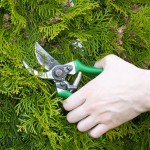 Tree pruning late in the season, or even over the winter itself, is a much better idea than most people realize. There are a few good reasons for this last of our fall landscape tips:
Tree pruning late in the season, or even over the winter itself, is a much better idea than most people realize. There are a few good reasons for this last of our fall landscape tips:
First, winter weather itself. Heavy snow falls and ice storms throughout the winter accumulate on the plant. The more branches and stems throughout the plant means more places for precipitation to accumulate. More accumulation means more weight pressure pulling down on branches and stems. When that weight gets to a certain point, you get stems that snap and branches that break. Having this breaking and tearing is a lot less healthy for your plants than a clean cut would be, and adds stress to the plant when it’s not actively growing and trying to repair itself.
Secondly, it can cost you less money. Less leaf tissue to haul away means less weight for your tree pruning company to carry away, which may reduce your cost. A smaller amount of leaf tissue to clean up can mean less on-site clean-up; this can reduce the man-hours invested in your pruning job. Less debris, less clean-up, and fewer man-hours can translate into lower pruning costs for you, the customer.
Lastly, there’s a really good cultural reason for pruning late in the year. Late season and dormant pruning, for certain species of tree, prevents the spread of diseases. In particular, you should really consider having your oaks and elms pruned very late in the season or while dormant to avoid or slow the spread of Oak Wilt and Dutch Elm Disease.
Getting your trees pruned later in the season is good for the health of your plants and potentially for your budget. Don’t overlook this important part of preparing your landscape for the winter.
BONUS:LAWN CARE TIPS FOR LATE FALL!
Okay, you’ve made it this far! So, we’re going to give you a couple of bonus tips for your lawn!
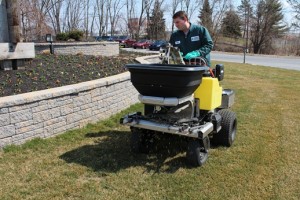 Do a late fall fertilization for your lawn.
Do a late fall fertilization for your lawn.
Your turf is made up of thousands of individual plants. The reasoning is the same for your lawn as for your landscape plants – the plants are storing up nutrients so they can overwinter. Make sure you feed the lawn late in the season, one last time, with a slow-release fertilizer (often, this is called a “winterizer”).
Secondly, make sure you core aerate.
This one takes a little more explanation. Soils in North America generally fall into 3 types: sandy soils (like in Florida) that are very loose; clay soils (like here in Central Pennsylvania) that are very dense; and loamy soils, which are the happy middle ground between sandy and clay soils.
Clay soils (which is what we have locally) get very compacted and hard over time. Just normal wear-and-tear from mowing, walking, and even rainfall push this already dense soil closer to together. It just keeps getting harder and harder over time.
Your landscape plants (trees and shrubs) have thick, “woody” roots that can sort of “muscle” through the dense clay without as much of a problem. Your turf, on the other hand, has a very fine, “hairy” kind of root structure. The soil eventually gets to the point where the roots can’t push their way through anymore, and the turf will decline. This compacted soil can also prevent water from flowing through properly, causing a shallow root structure and fostering diseases at the crown of the plant (where the grass plant actually emerges from the soil).
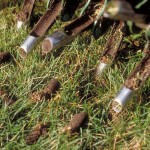 How to perform core aeration
How to perform core aeration
Using equipment to regularly pull out plugs of clay soil allows water and air flow at the root level. This adding of oxygen to the soil (hence the term “aerating”) breaks up it up a little bit, making it softer, and allowing the roots to spread and water to flow through the soil properly, creating a deeper growing root.
One of the more common objections we get from clients about this service is “It makes a mess of my lawn.” Aeration often does make the lawn muddy and messy for a week or two until the cores break down. However, it’s a lot less muddy than when you lose turf coverage because the roots are dead and you have large bare spots. Also, having the lawn aerated regularly is usually cheaper than a major lawn renovation. Those renovations will eventually be needed if you ignore an aeration.
Contact Us
If you have additional question about any of these services, we’d be thrilled to speak with you! Contact our office to request a free consultation.

